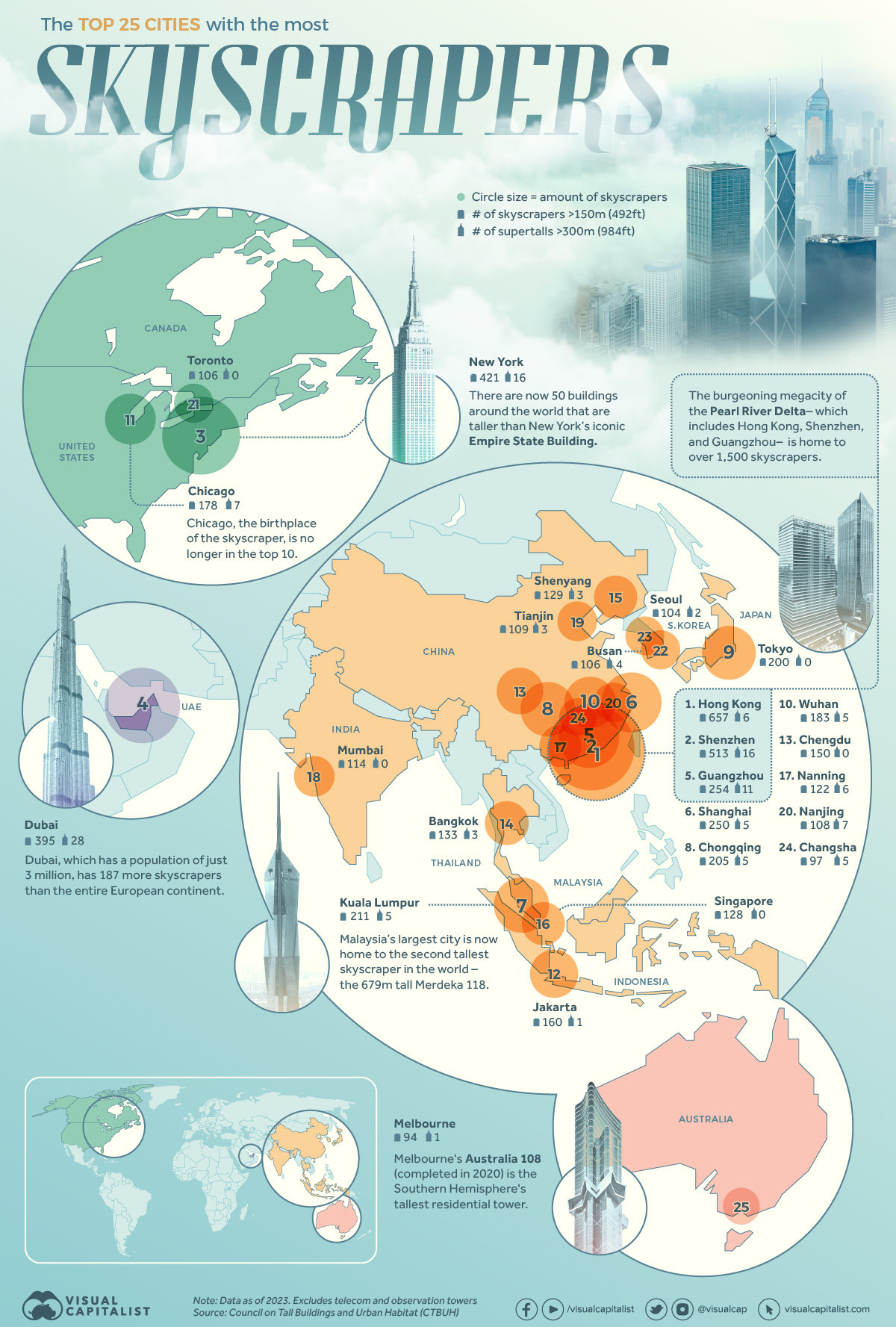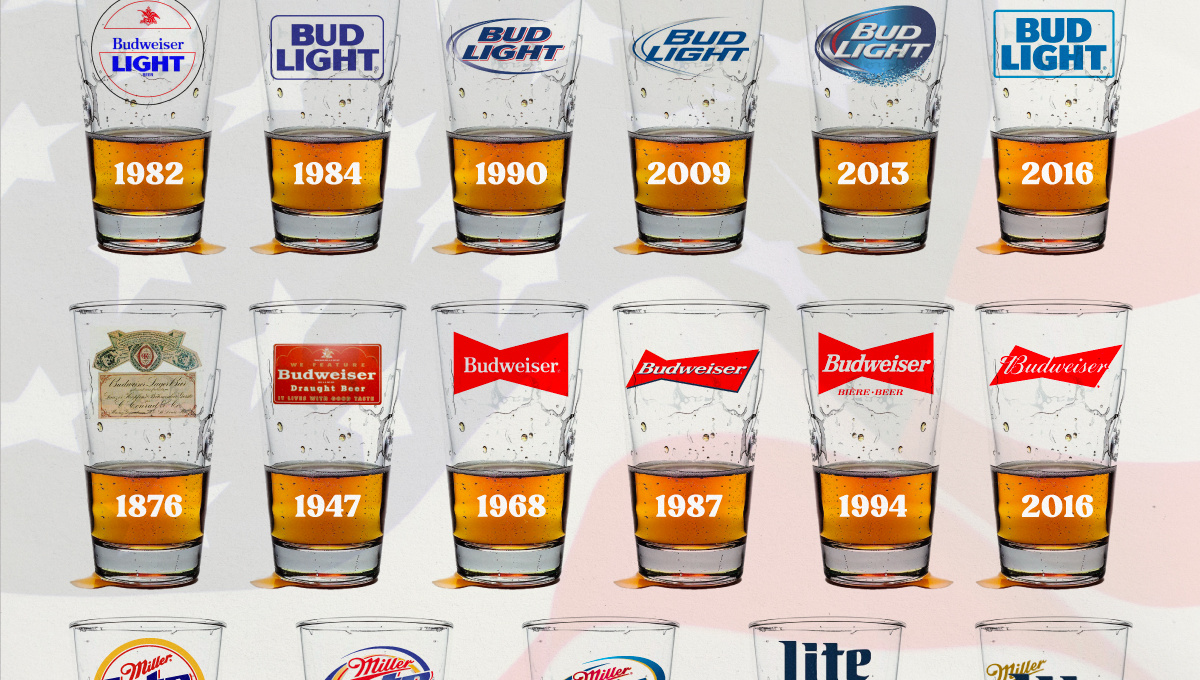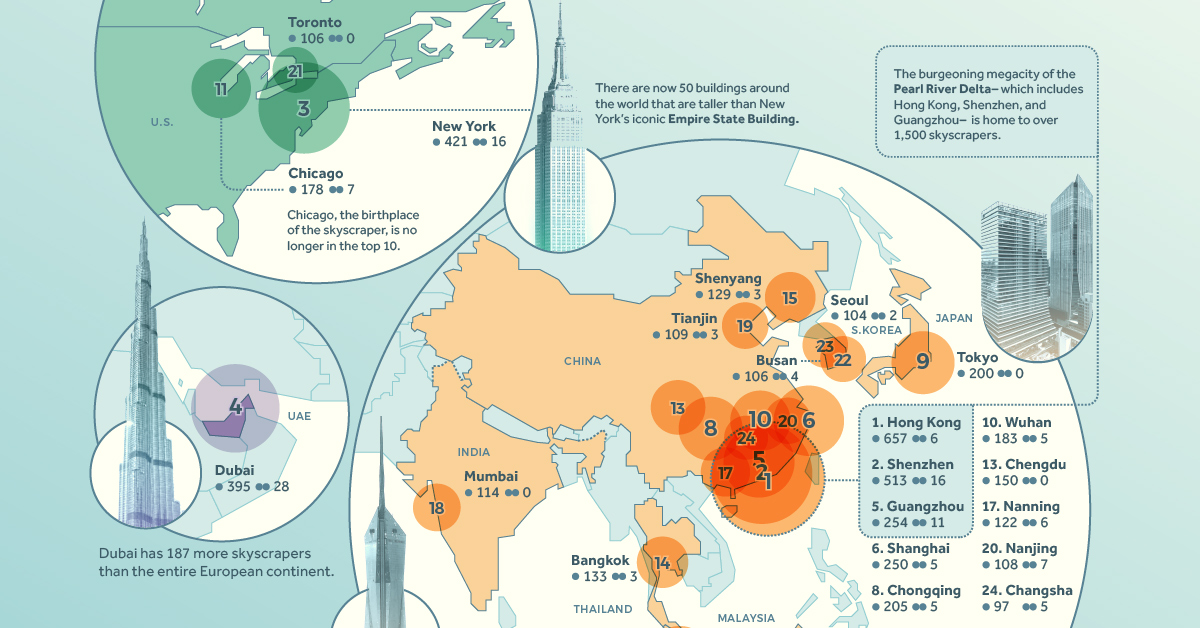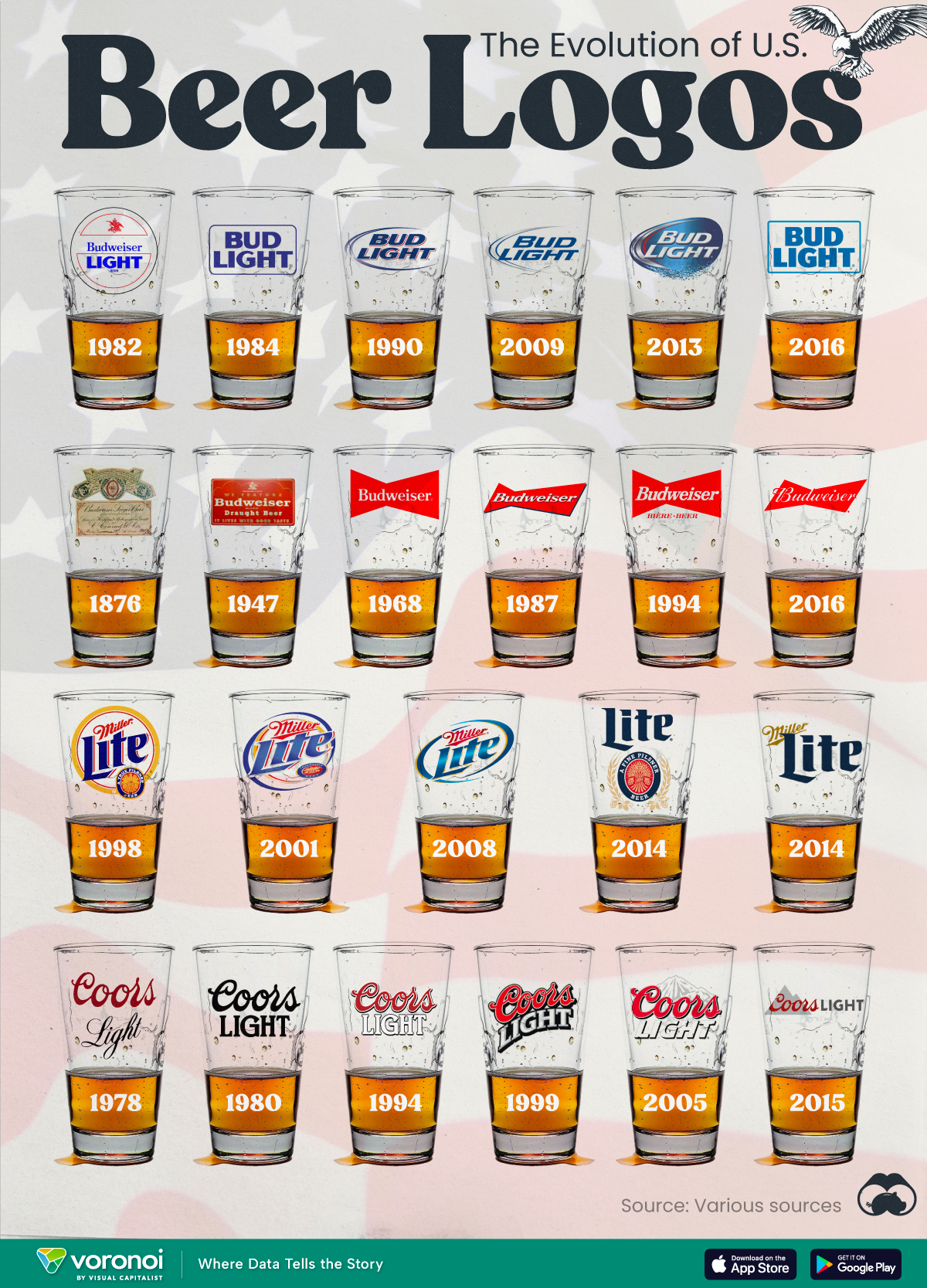Misc
Ranked: The Cities with the Most Skyscrapers in 2023

Ranked: The Cities with the Most Skyscrapers in 2023
When it comes to soaring skylines and architectural marvels, no country has embraced the vertical revolution quite like China.
In this graphic, which uses data from the Council on Tall Buildings and Urban Habitat (CTBUH), we reveal the 25 cities with the most skyscrapers and supertall buildings globally.
Unsurprisingly, China’s cities dominate the list, solidifying the country’s reputation as a global powerhouse of tall buildings.
The 25 Top Cities by Skyscraper Count
Topping the charts is Hong Kong, with an impressive 657 skyscrapers, including six supertalls (buildings over 300 meters tall).
| Rank | City | Country | Skyscrapers (>150m) | Supertalls (>300m) |
|---|---|---|---|---|
| 1 | Hong Kong | 🇨🇳 China | 657 | 6 |
| 2 | Shenzhen | 🇨🇳 China | 513 | 16 |
| 3 | New York City | 🇺🇸 United States | 421 | 16 |
| 4 | Dubai | 🇦🇪 United Arab Emirates | 395 | 28 |
| 5 | Guangzhou | 🇨🇳 China | 254 | 11 |
| 6 | Shanghai | 🇨🇳 China | 250 | 5 |
| 7 | Kuala Lumpur | 🇲🇾 Malaysia | 211 | 5 |
| 8 | Chongqing | 🇨🇳 China | 205 | 5 |
| 9 | Tokyo | 🇯🇵 Japan | 200 | 0 |
| 10 | Wuhan | 🇨🇳 China | 183 | 5 |
| 11 | Chicago | 🇺🇸 United States | 178 | 7 |
| 12 | Jakarta | 🇮🇩 Indonesia | 160 | 1 |
| 13 | Chengdu | 🇨🇳 China | 150 | 0 |
| 14 | Bangkok | 🇹🇭 Thailand | 133 | 3 |
| 15 | Shenyang | 🇨🇳 China | 129 | 3 |
| 16 | Singapore | 🇸🇬 Singapore | 128 | 0 |
| 17 | Nanning | 🇨🇳 China | 122 | 6 |
| 18 | Mumbai | 🇮🇳 India | 114 | 0 |
| 19 | Tianjin | 🇨🇳 China | 109 | 3 |
| 20 | Nanjing | 🇨🇳 China | 108 | 7 |
| 21 | Toronto | 🇨🇦 Canada | 106 | 0 |
| 22 | Busan | 🇰🇷 South Korea | 106 | 4 |
| 23 | Seoul | 🇰🇷 South Korea | 104 | 2 |
| 24 | Changsha | 🇨🇳 China | 97 | 5 |
| 25 | Melbourne | 🇦🇺 Australia | 94 | 1 |
Hong Kong, along with Shenzhen (#2), and Guangzhou (#5) are part of the burgeoning megacity known as the Pearl River Delta, which is home to over 1,500 skyscrapers. This is even more impressive when considering that Shenzhen was a small fishing village until the 1970s.
New York City secures the third position on the list, boasting an impressive tally of 421 skyscrapers. Although it may have relinquished its title to Chinese cities, the city’s skyline endures as a globally renowned symbol, prominently featuring the iconic Empire State Building. Notably, while the Empire State Building enjoys widespread familiarity, it no longer ranks among the world’s 50 tallest structures.
Rounding out the top five is Dubai in the United Arab Emirates, which grabs the fourth position with 395 skyscrapers, a staggering 28 of which are supertalls. This desert oasis has become synonymous with grandiose architecture and record-breaking structures, exemplified by the Burj Khalifa, which is the world’s current tallest building at 828 meters (2,715 ft).
China’s Numbers in Context
Looking at this data from another perspective, China actually has more skyscrapers on this list than the rest of the world combined.
| Country | Cities in Top 25 | Skyscrapers | Supertalls |
|---|---|---|---|
| 🇨🇳 China | 12 | 2777 | 72 |
| 🌐 Rest of World | 13 | 2350 | 67 |
China’s rapid urbanization, economic growth, and ambitious construction projects have fueled this impressive feat. There’s no doubt that the country’s relentless pursuit of vertical development, coupled with its booming population and thriving cities, has positioned China as the unrivaled leader in the global skyscraper race.
The Future of the Global Skyline
As the world continues to reach new heights in architectural marvels, there are even more supertall skyscrapers in the pipeline that will reshape skylines across the globe.
From the soaring Jeddah Tower in Saudi Arabia, poised to surpass the Burj Khalifa as the world’s tallest building, to the remarkable Merdeka 118 in Kuala Lumpur, which is set to claim the title of the world’s second-tallest structure when it opens in June 2023, these projects will captivate city dwellers for years to come.
Even as these new monumental buildings rise, China’s prominence in the world of skyscrapers—with three cities in the top five globally—is likely to remain unchallenged.
Misc
The Evolution of U.S. Beer Logos
In this graphic, we analyze the evolution of popular U.S. beer logos like Budweiser, Coors Light, Bud Light, and more.

The Evolution of U.S. Beer Logos
This was originally posted on our Voronoi app. Download the app for free on iOS or Android and discover incredible data-driven charts from a variety of trusted sources.
Despite selling a popular product, beer companies have to be creative to stand out in a competitive market.
In this graphic, we analyze the evolution of some U.S. beer logos based on various sources. We chose brands based on a mixture of criteria, including popularity (based on YouGov surveys), availability of logo assets, and those with interesting developments.
Bud Light Back to the ’80s
Despite recent backlash and calls for a boycott after sending a commemorative can to transgender influencer Dylan Mulvaney, Bud Light remains one of America’s best-selling beers.
The brand of light beer, owned by the Anheuser-Busch company, has switched from its more circular logo with italic letters adopted in the 1990s back to the Bud Light badge of the 1980s. It is composed of heavy uppercase lettering, written in two levels in a shade of blue with the inscription placed on a solid white background and enclosed in a thin rectangular frame.
Miller Lite Goes Old School
After following a similar approach to Bud Light’s branding throughout the 2000s, Miller Lite decided to undergo a major rebranding in 2014.
The company returned to its 1970s roots, once again combining a white can with its original blue, gold, and red logo. The redesign was largely considered a success, given that Miller Lite sales immediately increased following the change.
A Symbol of American Brewing
The oldest brand on our U.S. beer list, the Budweiser logo, has undergone more than 15 changes over the years.
The design of two connected triangles represents a red bow tie, as a symbol of American brewing.
The colors of the Budweiser logo include a vibrant red, which helps the logo stand out and be easily recognizable from a distance. Studies also suggest that the color red stimulates appetite. Meanwhile, the white inscription symbolizes purity and cleanliness.
Curious to learn more about the beer market? Check out this graphic about global beer consumption.
-

 Energy6 days ago
Energy6 days agoMapped: The Age of Energy Projects in Interconnection Queues, by State
-

 AI2 weeks ago
AI2 weeks agoVisualizing AI Patents by Country
-

 Markets2 weeks ago
Markets2 weeks agoEconomic Growth Forecasts for G7 and BRICS Countries in 2024
-

 Wealth2 weeks ago
Wealth2 weeks agoCharted: Which City Has the Most Billionaires in 2024?
-

 Technology2 weeks ago
Technology2 weeks agoAll of the Grants Given by the U.S. CHIPS Act
-

 Green1 week ago
Green1 week agoThe Carbon Footprint of Major Travel Methods
-

 United States1 week ago
United States1 week agoVisualizing the Most Common Pets in the U.S.
-

 Culture1 week ago
Culture1 week agoThe World’s Top Media Franchises by All-Time Revenue
















